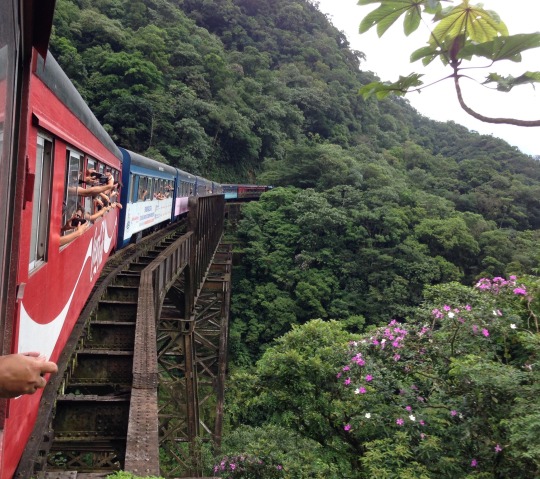#the state of paraná
Text

Pine sawmill in the State of Paraná, Brazil
French vintage postcard, mailed in 1935 to Saint-Quentin, France
#postkaart#sawmill#the state of paraná#pine#paran#carte postale#french#briefkaart#brazil#old#saint-quentin#sepia#france#postkarte#vintage#postal#photography#state#saint#1935#mailed#quentin#ephemera#postcard#tarjeta#photo#ansichtskarte#historic
8 notes
·
View notes
Text
.
#I hate curitiba man I hate paraná this state is full to the brim with fash I hate the people I study with and the people I live with#I wish I didn't have to bite my tongue about everything I believe in because I have no one to back me up
5 notes
·
View notes
Text
Donate to victims of Brazil floods from abroad
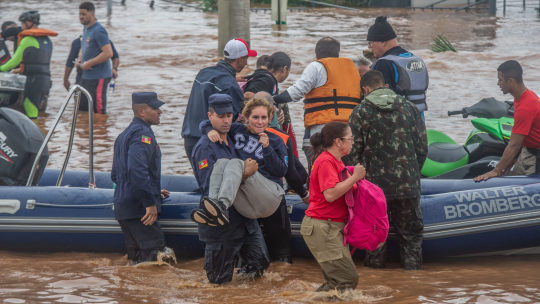
Brazil’s southernmost state of Rio Grande do Sul, a state the size of Ecuador, has been devastated by historic floods, with most of its 497 municipalities in a state of public calamity. Authorities have described the crisis as “war-like” and consider it the state’s worst crisis caused by natural disasters ever.
Roughly 200,000 people were forced out of their homes, according to state officials. The death toll, which has been growing fast, is inching closer to the mark of 100 — and there are still more than 130 people missing.
A series of public and private initiatives are collecting donations in order to mitigate the devastating effects of the crisis. Post offices in the states of São Paulo and Paraná, as well as some in Rio Grande do Sul, for example, offered to collect and transport donations free of charge.
Continue reading.
#brazil#brazilian politics#politics#environmental justice#mutual aid#rio grande do sul floods 2024#mod nise da silveira#image description in alt
3K notes
·
View notes
Photo

Iguazú Falls or Iguaçu Falls, border of the Argentine province of Misiones and the Brazilian state of Paraná
831 notes
·
View notes
Text
Climate change is undeniable
Brazil's southernmost state, Rio Grande do Sul, is going through the worst flood of its history. Almost half the state is underwater, including state capital Porto Alegre. There are pictures in news sites that are absolutely terrifying. I have seen videos of at least five different bridges being carried out the the water in the past four days only.
Rio Grande do Sul underwent a big flood last September, and it was already incredibly frightening. There were storms in June and November too, but September was bigger. And this current storm has been lasting longer already. Things are likely to get worse in the next week - weather forecast says rain will give the state a break starting tomorrow, May 5th, but by the 8th it should be raining again.
The pictures explain better than my words can:
youtube
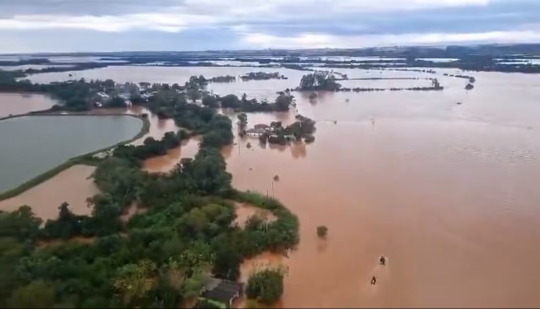

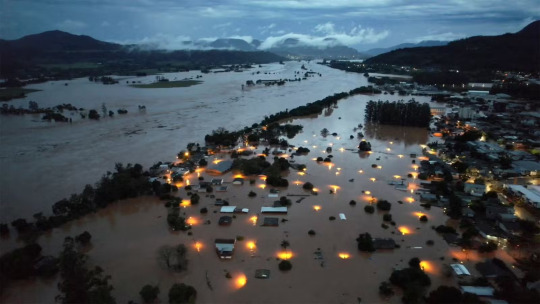
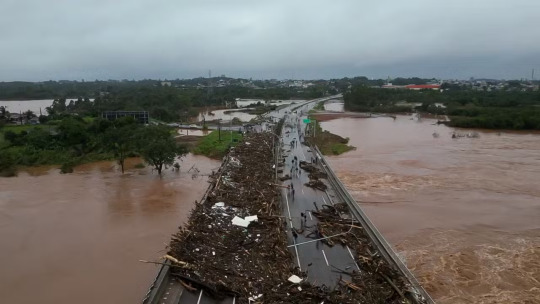
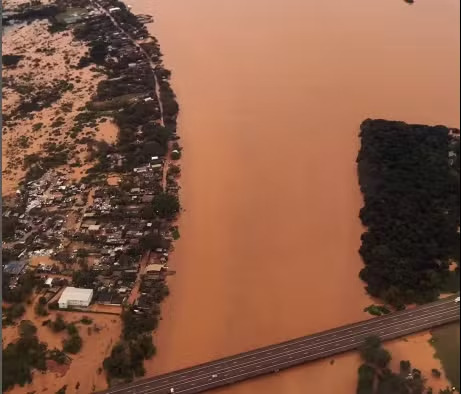
But if Rio Grande do Sul and its neighboring state Santa Catarina have been facing massive floods, the rest of the country is going through the fourth heat wave of 2024 (they consider a heat wave when the weather is over 5° C above the average temperature, for several days). Now, you must be thinking: Brazil is a tropical country, it's supposed to be hot.
It's not supposed to be 37° C in fucking May.
We have a state in the southern region, called Paraná, whose capital city, Curitiba, is the coldest state capital in Brazil. In fact, there is a stereotype (very much confirmed) that Curitibans are insufferable when it comes to talking about the weather, because no Brazilian, in any place of the internet, talking from anywhere in Brazil, can complain about the cold without a Curitiban showing up from nowhere and saying "well, but here in Curitiba is colder". They really are that insufferable.
Curitiba's average temperature for May is 12° C to 21° C. I just checked: it's 28° C right now. Curitibans have taken to forums to complain about the heat, which must be unheard of, because those assholes (I love you guys, but you're assholes) can't stop talking about the cold all damn year. I have never, in 40 years of life, have seen them talking about the heat so much.
When I was a kid, i used to wear coats for some periods of the year. Rio has never been a place to wear heavy coats, but you know, long-sleeved shirts, a denim jacket during the winter? Normal.
I can't remember the last time I consistently wore a jacket. It was probably before the pandemic, and only because of the air-conditioner at work. It just isn't cold enough to wear anything more than short sleeves for more than three or four days in the entire year.
Climate changes are undeniable. Anyone who's denying it is either incredibly stupid or incredibly ill-intentioned.
96 notes
·
View notes
Photo
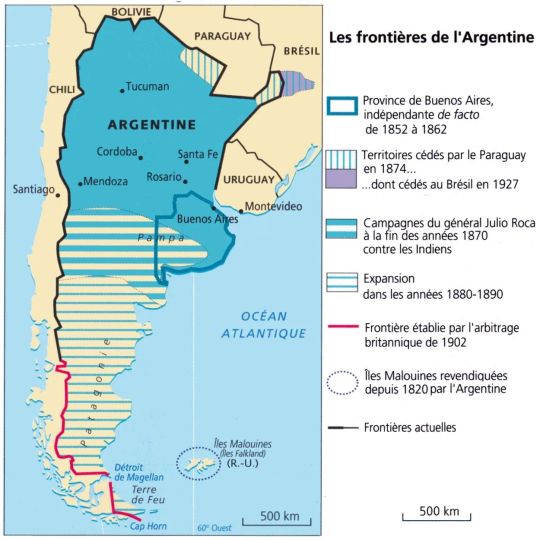
Argentina's borders
« Atlas des peuples d’Amérique », Jean Sellier, La Découverte, 2006
by cartesdhistoire
In 1853, Argentina adopted a constitution modeled after that of the United States, which combined federalism with presidential governance. However, Buenos Aires did not ratify this constitution and seceded until 1862. It did not become the federal capital until 1880, following its separation from the province.
In the northern regions, territorial expansion was fueled by the War of the Triple Alliance (involving Brazil, Argentina, and Uruguay) against Paraguay between 1864 and 1870. Argentina occupied Misiones (located between the Paraná and Uruguay rivers) in 1868, as well as part of the Chaco (which is now the Argentine province of Formosa).
In the southern territories, expansion occurred at the expense of indigenous peoples who had never been subjugated by the Spaniards and who regularly raided the pampas (the provinces of Buenos Aires and Santa Fe). In 1878–1879, General Julio Roca decisively ended these raids by destroying both the summer camps and winter settlements of the indigenous peoples. This "conquest of the desert" led to the incorporation of 650,000 km² of arable land.
In Patagonia, resistance was not primarily from indigenous peoples, who were few in number, but rather from Chilean territorial ambitions. In 1884, Argentina established a foothold in Ushuaïa (Tierra del Fuego). A British arbitration took place in 1902, resulting in Argentina securing the Atlantic side and Chile obtaining control over the Pacific side.
In the South Atlantic, the Falkland Islands archipelago (which received its name from sailors from Saint-Malo) was uninhabited until 1764 when both the French and English undertook colonization efforts. The French departed the archipelago in 1770, followed by the English in 1774. However, after Argentina established a garrison there in 1820, the English protested, expelled the Argentines in 1832, and declared the islands a crown colony in 1833. By 1900, the archipelago had 2000 inhabitants of British origin. In April 1982, the Argentine armed forces attempted to seize the Falklands, but the English compelled them to surrender in June of the same year.
64 notes
·
View notes
Note
I am watching a video with criticism of geographical determinism in worldbuilding and realized that I don't really remember seeing any fictional stereotypic merchant state that relies on rivers.
Norse and Rus were whom I had in mind, but to my knowledge British and Japanese people also heavily utilized rivers for trade and I would be very surprised if Ancient Chinese people didn't.
I don't know about history of First Nations of North America and did they have trade in our understanding, but I heard that river system of North America is so convenient that the entire 19th century demand for transportation could have been covered by it alone, without trains.
Just some ideas
Freshwater systems are woefully underused in worldbuilding. The other day I was reading about the history of my region and I was amazed at how big and sophisticated native canoes were in the Paraná, the Paraguay and the Amazonas, and how virtually nobody talks about it. We are talking about ships that could hold about 30 people and some were bigger than Columbus caravels. For centuries into the colonial era, the Spanish and Portuguese hired or pressed into service native navigators for the rivers which were though to navigate as a sea. Still before that, they were the major arteries of commerce and trade through the continent, this is well known. Even Patagonian goods are reported in Corrientes (North of Argentina) which indicates that trade there got very far. As for the Chinese, not only rivers were important to the but also they boasted an amazing canal system but that's about all I know.
One thing I learned recently about rivers and cities is that cities were often founded on the side of rivers, yes, but almost never at their mouth. Look for example at Paris, Rome, London, the Egyptian capitals. They were founded by the river, but the mouth of the river next to the sea is where the delta is, and deltas always change and flood, carrying mud and slit, they aren't good places to build at all. Good river cities are built in the 'deep side' of the river where you can build ports, not in the side where sediment accumulates. Another issue with river cities are marshlands. For example, I remember reading that the marshlands of ancient Rome were drained at great cost. Ancient peoples knew that marshes were 'unsanitary' even if they didn't know why (it's because they host mosquitos and parasites, not because of anything bad wetlands have on itself) and they had to deal with them. There are some exceptions to this, like Venice which was basically built on a marshland (or the Netherlands).
And indeed rivers were (and still are! I see ships going up and down the Paraná every weekend!) a very efficient way of transportation. There's lots about it written in Europe, but river barges were basically the railroads of their time. Before the advent of railroads, people in Europe (and China) weren't thinking roads, but canals, the French built a lot of canals at great expense which became obsolete later by railroad.
Unfortunately the sources about river canoes and transportation in America (continent) are often tucked away in papers and history books, there really isn't that much accessible literature and illustrations about it. Which is a goddamn shame because learning about native canoes bigger than Spanish caravels (and they were still building them in Paraguay and Argentina during colonial times, according to my sources) blew my mind.
32 notes
·
View notes
Note
Can you tell me some slugs that have very unique patterns or body shapes?
some Athoracophoridae:
some Veronicellidae, like my slugs:
Testacella has a shell, but it’s not really doing anything:
Gaeotis is another (entirely unrelated) semi-slug with a wonderful appearance:
and something from the most “typical” family of slugs, Limacidae. probably Europe’s prettiest land gastropod:
198 notes
·
View notes
Text
┄─̸─̟┈┄┄┄┄┄┄┄🇧🇷┄┄┄┄┄┄┄─̸─̟┈
My Brazilian Girl

┄─̸─̟┈┄┄┄┄┄┄🇧🇷┄┄┄┄┄┄┄┄─̸─̟┈
─̸─̟Warnings: None, just a beautiful romance💗
─̸─̟┈┄ Wow!😱 I'm so glad I wrote this, I wasn't planning on doing anything considerably big, so there will be a part 2! probably roll SMUT in the next chapter. Enjoy and I'm reading all the ideas you sent me and planning your plots, this will probably end up becoming a series.💗
Sorry if I hear mistakes, I'm not fluent but I did my best! 🇧🇷
Explaining some things you can read: Paraná is a Brazilian state, located in the south.
Bora!, it's a slang used throughout Brazil, which basically means let's go!
┄─̸─̟┈┄┄┄┄┄┄🇧🇷┄┄┄┄┄┄┄┄─̸─̟┈
It had been 2 months since you got your British citizenship, you had been in London for 2 years and arrived in the city decided to have a life outside Brazil, after all you got an exchange program to finish college in London, and you already saw yourself in an internship at a small local team in the city that was financed and supported by a few companies. As soon as your college and internship ended, you found yourself looking for a permanent job, lucky for you the coach of the football team had a contact at Tottenham, who was one of the great supporters of the team. You found yourself so grateful for that kind man, and the team of young people with a bright future ahead, all of whom would stay in your heart.
You knew that it would be difficult to get that job at Tottenham as a physiotherapist, after all you only had experience with the team of young athletes supported by them, and they would probably have more qualified people in front of you, who probably already worked in other clubs. You felt like running away from your interview that day, but luckily for you everything worked out, as the coach of the team where you trained was a good friend of your new boss in physiotherapy, whose name was George.
After that day you went through a few more conversations with some of the club's staff, to sign all the legal paperwork, and terms of employment; What has been 3 days since your interview, but lucky for you you would only work the other week, and today was already that day. You were so excited and nervous, you had little knowledge of the Tottenham players but you knew Son, Harry Cane, Emerson and Richarlison.
As soon as you arrived at your work environment, you found yourself organizing your own room to get ready for the athletes you were going to attend, and after that you changed your clothes for the uniform left to you by Tottenham in your room. Your living room was cool so you wore a black tank top and team shorts, you didn't know if you wore the full outfit so you just got the shorts and your white lab coat instead of the jacket.
You found yourself looking in the mirror for a few seconds, and then you smiled when you saw the Tottenham crest on your shorts. "I really don't know if I should wear this lab coat… what if it's too formal?" - I was soon taken out of my little conversation by the door being opened, as soon as I turned around I was face to face with 2 athletes, these being Son and Richarlison, God help me not to panic! Son had one hand around Richarlison and his arm around her neck.
"We are so sorry Doctor..." - "y/n please, what happened?" - I said worried going to them and helping Son to sit Richarlison in my chair, as soon as I sat down he touched his thigh hissing in pain.
“We were at the gym talking after training and God, we were sitting on the floor and Ivan was going to put the gym weight in the right place, but he accidentally fell and landed on Rich thigh" - He said running a hand through his hair, he was worried about Your Friend.
"We haven't found anyone else from the physical therapy team, could you take a look at him?"
"Don't worry, I'll take a look." - I nodded and knelt beside Richarlison, before touching him I looked at him "I'm going to lift your shorts a little ok? And let me know if anything hurts" - He nodded and I gently pulled her shorts up As far as I could, the area was starting to swell and turn red.
With subtle touches I felt the area with both hands, and as soon as I touched it lightly he hissed in pain "Sorry...I'll finish now, Son, can you tell me how heavy the object was?" - I get up going to the drawers and taking out a refreshing spray that would relieve the local pain, and then going to the small fridge that had ice packs.
"I think it was a 4kg...it wouldn't break a bone like that right?" - The Korean said leaving close and giving me space to kneel again beside Richarlison, and so I passed the spray.
"It doesn't hurt a lot anymore when you fall, which leaves the place swollen and painful, it's like hitting your thigh accidentally... hold the ice pack now, okay? It will help to deflate.." - I held his front and he took a while to take more accepted putting on his leg.
"I'm relieved that it's nothing serious, I'll let our colleagues know, our training starts soon, but I'll pack up his everything and take him to his apartment" - he smiled at me and then touched his friend's shoulder who stared at him. "I'll be right back, okay?" - Son said slowly to Richarlison who nodded in agreement and soon left the room.
And so I took a sheet and started making a situation report. "Doctor I...play?" - Richarlison said and I looked again, I didn't understand what he said because I was distracted "Can you repeat that?" - then he did a kick with the other leg. "Play...sabe (You know?)" - He said staring at me, and I then realized, of course, Son said slowly because Richarlison wasn't so fluent in English yet.
I let out a small laugh at my mistake, and he stared at me blankly. "Oh desculpe Richarlison, não sabia que você não era tão fluente em inglês (Oh sorry Richarlison didn't know his English wasn't fully fluent)" .
He then stared at me surprised by the sudden Portuguese "Você fala português, que impressionante, você é Brasileira(You speak Portuguese, how impressive, are you Brazilian girl?)" - Richarlison let out a relieved smile.
"Sim sou Brasileira mais vivo em Londres a 2 anos, sou do Paraná, nascida em Curitiba (Yes I'm Brazilian girl but I've been in London for 2 years, I'm from Paraná, born in Curitiba)" "Que incrível... bem vinda ao Tottenham (How amazing..welcome to Tottenham Doctor)" - He extended his hand and I approached him squeezing, both with a smile on your face.
"Me chame de Lua por favor, como esta sua dor? (Call me y/n please, how is your pain? )" - I said softly touching her wrist to withdraw her hand and then ran my fingers gently over the area.
"Suportável agora.. (Bearable now..)" - He said and then we stared at each other for a few seconds "Isso é bom.. (That's good..)" - I quickly broke the look embarrassed, but kept my composure.
"Quero que venha aqui todo dia pois presciso avalia-lo ate o inchaço sumir e faremos exercícios para ajudar na recuperação, lamento dizer mais nada de treino por 3 dias e nesse período não faça muita força ou exercícios. (I want you to come here every day because I need to evaluate you until the swelling is gone and we will do exercises to help with the recovery, I'm sorry to say no more training for 3 days and in that period don't do too much strength or exercises)".
"Esta bem y/n (It's ok y/n)" - He said my name with so much good that I could swear his smile had ulterior motives.
"Bem.. prescisa de muletas por hoje certo, não quero nenhum peso sobre sua perna (Well..need crutches for today alright, don't want any weight on your leg today)" - I walked over to the corner cupboard where there were two pairs of crutches, I picked them up going to him.
"Vamos achar Son, esta de folga Richarlison (Let's find Son, he's off today Richarlison)" - He agreed and then got up with the support of his hand on the chair and then stood on one leg, when he got up he was so close to me that his chest his collided with my breasts. We both stared at each other again and I let out a breath I didn't know I was holding, God this room was cool but why is it so hot right now.
His gaze was so serious but at the same time so calm about me. "B-bem deixe-me..ajudar (W-well let me..help)" I said and pulled away a bit putting the crutches under each of his arms.
"Sim... e obrigada y/n (Yes..thank you y/n)" - he said softly "É..so meu trabalho (It's..just my job)" - Said silly and soon the door was opened, we both looked and saw that it was Son.
"I took his things Doctor, bora? (Let's go?)" Son said with a smile to his friend and I couldn't help but laugh hearing him say bora.
"Bora! Bye y/n vejo você amanhã (Let's go! Bye y/n see you tomorrow)" - Richarlison said with a smile to me and I waved to both boys saying goodbye.
As soon as they left I fell to my knees on the floor with my face in my hands.
"Oh God... what a hot man... "
┄─̸─̟┈┄┄┄┄┄┄🕊┄┄┄┄┄┄┄┄─̸─̟┈
Leave a comment to know what you think!
#richarlison x reader#richarlison andrade#richarlison imagine#richarlison#richarlison smut#reader x Richarlison#imagine#soccer#football player#football#football player imagine#fluff#smut#son heung min#Son Heung-min imagine
282 notes
·
View notes
Text
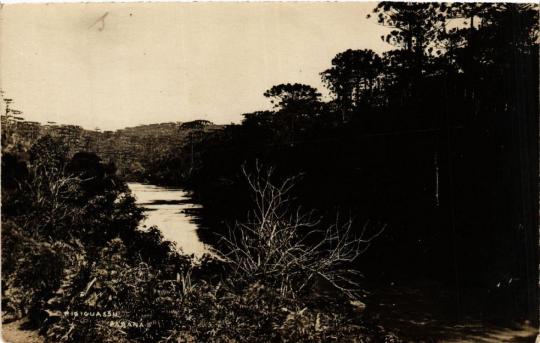
Iguazu River in the State of Paraná, Brazil
Brazilian vintage postcard
#tarjeta#postkaart#sepia#state#river#historic#brazil#paran#photo#postal#briefkaart#photography#the state of paraná#vintage#ephemera#ansichtskarte#old#iguazu river#postcard#iguazu#postkarte#carte postale#brazilian
4 notes
·
View notes
Text

The Iguazu Falls, located on the border between the Brazilian state of Paraná and the Argentine province of Misiones, offer a very special kind of natural spectacle.
89 notes
·
View notes
Text
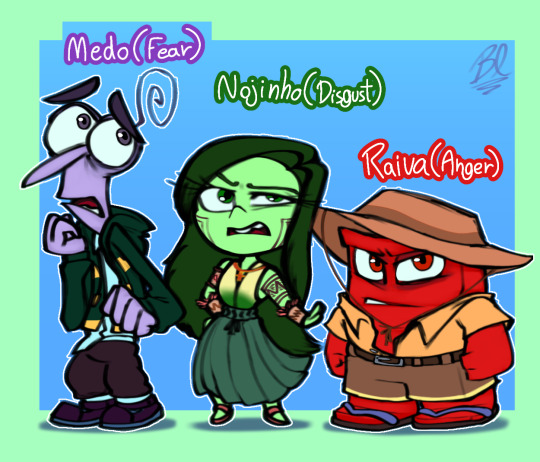
The Trio is here!!!🇧🇷 And yes, each emotion will represent a different state of Brazil. Fear is from Paraná, Disgust is from Amazonas and Anger is from Ceará.
I will explain the differences between them in the next post about this universe.👀✨️
#inside out#inside out 2#inside out fandom#disney pixar#fanart#art#au#alternate universe#ibis paint x#brasil#brazil
45 notes
·
View notes
Text
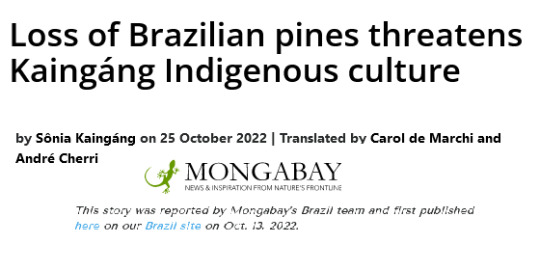

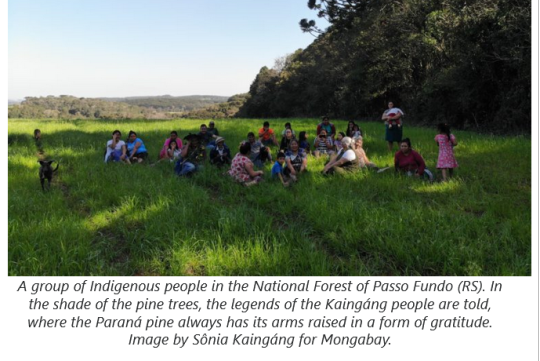

Besides its ecological relevance, the disappearance of the Paraná pine (Araucaria angustifolia), a tree that is native to Brazil, also threatens the survival of an entire people: the Kaingáng, the third-largest Indigenous population in Brazil, with a contingent of 45,000 people.
The Paraná pine forest, also called mixed ombrophilous forest, is one of the most devastated ecosystems in Brazil. In the past, it covered 40% of the territory of Paraná state, 30% of Santa Catarina and 25% of Rio Grande do Sul. Today it has been reduced to 3% of its original extent [...].
“The Kaingáng [people] need to exist not only as people, but also as a culture produced in this environment of the araucária tree, of the forest, of the environment, and this is a cultural retake, of resilience,” says historian Bruno Ferreira, a member of the Kaingáng people who holds a PhD in education.
The Paraná pine occupies a noble space in Kaingáng culture. It is used for food, in formal education, as raw material for the production of handicrafts and as a resource for maintaining spirituality.
The seed harvested from this tree, the pine nut, for example, is consumed in various ways: roasted, cooked or pounded in a mortar and pestle and made into a flour called pisé.
But also, the plant species that grow under the tree serve as important nutritional sources, such as the nettle (pyrfér in the Kaingáng language), the fern (grỹ), the sinjir, a kind of vine, and the ka nĩgrẽg mushroom, taken from the trunk of the tree.
The resting and meals usually take place under the Paraná pine, moments when the teachings that promote the maintenance of the Kaingáng culture are orally transmitted. The Paraná pine also makes up Kaingáng myths [...].
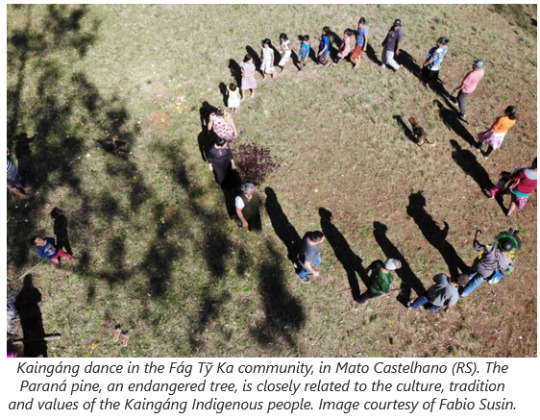
“[The Paraná pine] brings teachings to the families, to the Indigenous population, and to the spiritual knowledge of the kujá [spiritual leaders of the Kaingáng people], which were passed down by our ancestors,” says kujá Pedro Garcia, who was honored by the government of Rio Grande do Sul with a Cultural Trajectories Award in 2021.
The problem is that most of the Indigenous lands where the Kaingáng live no longer have Paraná pines. “When distributing araucária seedlings, a chief sought help and told us that the communities had no more pine trees and could not cut them down for the annual Kaingáng rite,” says Flávio Zanette, a researcher at the Federal University of Paraná and an expert in the study of the species in the country for almost 40 years. The ritual to which Zanette refers is the Kiki Koj, a ceremony in honor of the dead in which the trunk of the pine tree is a fundamental element.
Besides the cultural and religious character, the Paraná pine and the Kaingáng people also share a history of land degradation, with the Indigenous people being expelled from their traditional lands over decades [...].
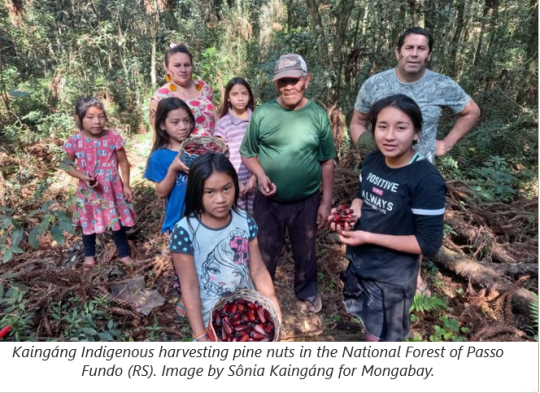
“In the late 1970s and early 1980s, the pine trees were cut down because the idea was that where there was a pine forest, other plants could be produced. And the space gave way to monoculture production,” Ferreira points out. Entire areas in Rio Grande do Sul have been named fág kava, “thin pine” in the Kaingáng language — an indication of the damage caused to the Paraná pine forest in the region over the last centuries. [...]
Even in a difficult scenario, the nobility of the cultural aspects and values of the Kaingáng people still persist in the figure of the Paraná pine. One of the places where this is visible is in the Mato Castelhano/Fág Tỹ Ka Indigenous land, in northern Rio Grande do Sul, where a community of about 300 people live in an area of 3,500 hectares (8,649 acres). The population of Fág Tỹ Ka is different from other Kaingáng communities, in that people have access to the pine trees through the National Forest of Passo Fundo, which overlaps with the Indigenous territory — the result of a negotiation that took almost a decade to come about. “Our ancestors passed through here, my grandparents lived here and there were many araucárias. Our access was difficult, there was a lot of resistance [...], but today we harvest the vine, the taquara and the pine nut,” says the chief of Fág Tỹ Ka, Jonatan Pỹn Sá [...].
The reaffirmation of the ancestral use of the land by the Kaingáng people from the Paraná pine may signal an intensification of responsible decision-making in order to avoid the loss of the tree in the coming years, as Ferreira says. “The Kaingáng culture needs the pine tree. It is our main plant, and its disappearance brings serious consequences because there is a destruction of the cultural source, food and resilience of the Kaingáng people,” says the historian. “Efforts to revitalize Kaingáng culture must be aligned with the resurgence of araucária planting in the territories of the Kaingáng people.”
---
Headline, images, captions, and original text by Sonia Kaingang. “Loss of Brazilian pines threatens Kaingáng Indigenous culture.” Translated by Carol de Marchi and Andre Cherri. As presented and published by Mongabay on 25 October 2022. Originally published at Mongabay’s Brazilian site on 13 October 2022. [Bolded emphasis added by me.]
231 notes
·
View notes
Text
Brazil to expand use of wolbachia bacteria against dengue fever
Infected mosquitoes will be released in six additional municipalities
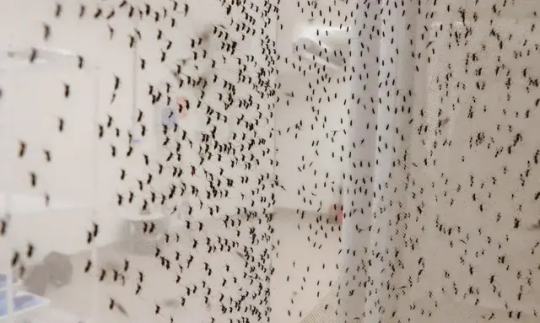
In July of this year, the first releases of Aedes aegypti mosquitoes infected with the wolbachia bacteria will commence in six municipalities across different states: Uberlândia in Minas Gerais; Londrina and Foz do Iguaçu in Paraná; Presidente Prudente in São Paulo; Joinville in Santa Catarina; and Natal, the capital of Rio Grande do Norte. The strategy will expand next year to 22 additional municipalities in Minas Gerais.
The Ministry of Health reports that Brazil is the pioneering nation to adopt this technology as a public policy initiative aimed at curbing dengue cases over the medium and long term.
The Wolbachia method involves introducing the bacterium into mosquito eggs in a laboratory setting, thereby producing Aedes aegypti mosquitoes that harbor the microorganism. These infected mosquitoes are incapable of transmitting viruses responsible for diseases such as dengue, Zika, Chikungunya, or yellow fever. As they reproduce, they pass on the bacteria to subsequent generations, leading to a reduction in disease transmission from mosquitoes to humans.
Prior to the release of mosquitoes, the local population is informed about the anticipated increase in mosquito numbers in the area. Ethel Maciel, Secretary for Health and Environmental Surveillance at the Ministry of Health, clarifies that insecticide application is prohibited in areas where mosquitoes are released. This is because the method focuses on altering the mosquito population by introducing wolbachia-infected mosquitoes to replace those that are not infected.
Continue reading.
8 notes
·
View notes
Text
Great women in paleontology: Diana Mussa | Grandes mulheres na paleontologia: Diana Mussa

🇬🇧 Diana Mussa, born in Campos dos Goytacazes on January 19, 1932, and passed away in Rio de Janeiro on May 8, 2007, was a renowned Brazilian geologist and paleobotanist, globally recognized for her expertise in Devonian flora. She was a trailblazer in this field in Brazil and also a respected professor at the Federal University of Rio de Janeiro.
The youngest of five siblings, Diana was the daughter of Lebanese parents. Since childhood, she harbored the dream of becoming a naturalist, driven by her deep interest in nature and natural processes. In 1952, she moved to Rio de Janeiro to study Natural History at the National Faculty of Philosophy, Sciences, and Letters of the University of Brazil (now UFRJ), where she also pursued Geology. During this time, she had the opportunity to intern under renowned researchers such as Dr. Fernando R. Milanez at the Rio de Janeiro Botanical Garden and Dr. Calvino Mainieri at the São Paulo Institute of Technological Research.
In the late 1950s, she joined the Convent of the Poor Clares to volunteer with underserved populations, and she was sent to Manaus. Between 1958 and 1961, she lived in Tefé, conducting research on fossilized woods and participating in missionary activities. After returning to Rio de Janeiro for health treatment, she joined the National Commission of Nuclear Energy and commenced her postgraduate studies in 1973 at the Institute of Geosciences of the University of São Paulo, under the guidance of Prof. Dr. Antonio Carlos Rocha-Campos. Her thesis, defended in 1982, on the Permian Lignitafofloras of the Paraná Basin, Brazil (States of São Paulo and Santa Catarina), was approved with distinction.
Diana became a researcher at the National Department of Mineral Production and later worked at the National Museum in Rio de Janeiro, where she became an Adjunct Professor of Paleobotany in 1993. Throughout her career, she described approximately 30 genera of fossilized plants, leaving behind an important legacy in the form of her collection of fossil wood slides. Additionally, she was a founding member of the Brazilian Society of Paleontology and a member of various other international and national organizations in her field. Her name inspired the naming of the genus Mussaeoxylon seclusum Merlotti 1998, for Gondwanan fossil gymnosperm wood from Brazil, and the species Glossopteris mussae Ricardi-Branco et al. 1999, for new Permian fossil leaves from São Paulo.
🇧🇷 Diana Mussa, nascida em Campos dos Goytacazes em 19 de janeiro de 1932 e falecida no Rio de Janeiro em 8 de maio de 2007, foi uma renomada geóloga e paleobotânica brasileira, reconhecida mundialmente por sua expertise na flora do devoniano. Ela foi a pioneira nesse campo no Brasil e também uma respeitada professora na Universidade Federal do Rio de Janeiro.
Filha de pais libaneses, Diana era a caçula de cinco irmãos. Desde a infância, cultivava o sonho de se tornar naturalista, devido ao seu profundo interesse na natureza e nos processos naturais. Em 1952, mudou-se para o Rio de Janeiro para estudar História Natural na Faculdade Nacional de Filosofia, Ciências e Letras da Universidade do Brasil (atual UFRJ), onde também cursou Geologia. Durante esse período, teve a oportunidade de estagiar com renomados pesquisadores, como o Dr. Fernando R. Milanez no Jardim Botânico do Rio de Janeiro e o Dr. Calvino Mainieri no Instituto de Pesquisas Tecnológicas de São Paulo.
No final dos anos 1950, ingressou no Convento das Clarissas para realizar trabalho voluntário com populações carentes, sendo enviada para Manaus. Entre 1958 e 1961, viveu em Tefé, onde conduziu pesquisas sobre madeiras fósseis, além de participar de atividades missionárias. Após retornar ao Rio de Janeiro para tratamento de saúde, ingressou na Comissão Nacional de Energia Nuclear e iniciou sua pós-graduação em 1973 no Instituto de Geociências da Universidade de São Paulo, sob a orientação do Prof. Dr. Antonio Carlos Rocha-Campos. Sua tese, defendida em 1982, sobre as Lignitafofloras Permianas da Bacia do Paraná, Brasil (Estados de São Paulo e Santa Catarina), foi aprovada com distinção.
Diana tornou-se pesquisadora do Departamento Nacional de Produção Mineral e, mais tarde, passou a trabalhar no Museu Nacional, no Rio de Janeiro, onde se tornou Professora Adjunta de Paleobotânica em 1993. Ao longo de sua carreira, descreveu aproximadamente 30 gêneros de vegetais fósseis, deixando um legado importante na forma de sua coleção de lâminas de lenhos fósseis. Além disso, foi sócia-fundadora da Sociedade Brasileira de Paleontologia e membro de diversas outras organizações internacionais e nacionais ligadas à sua área de atuação. Seu nome inspirou o batismo do gênero Mussaeoxylon seclusum Merlotti 1998, para madeira fóssil gimnospérmica do Gondwana brasileiro, e da espécie Glossopteris mussae Ricardi-Branco et al. 1999, para novas folhas fósseis do Permiano de São Paulo.
#science#paleontology#geology#universe#earth#paleobotany#biology#Diana Mussa#paleontologia brasileira#paleozóico#paleobotânica#paleozoic#paleontologia#women in science#women in paleontology
8 notes
·
View notes
